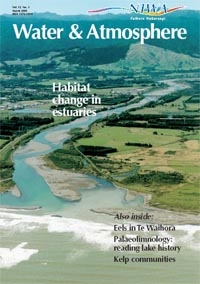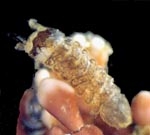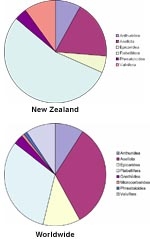PDF of this article (143 KB)

Kelly Merrin
New Zealand’s waters, especially the deep sea, remain one of the world’s reserves of yet-to-be discovered biodiversity.

It has been said that more is known about outer space than the depths of our oceans. So it’s not surprising that the huge diversity of deep-ocean habitats may not be appreciated as much as, for example, the Amazon rainforest. Recent research voyages have uncovered many fish and invertebrate species new to science. It is anyone’s guess how many thousands of species are still waiting to be discovered. This article covers just one group of crustaceans – the asellote isopods. Initial studies suggest that there is remarkable diversity in this group in the deep seas around New Zealand.
Asellotes: deep-sea specialists

The suborder Asellota is a large group of aquatic isopods. The group has 29 known families and over 1800 species worldwide, in habitats ranging from freshwater to marine, and from tropical to polar waters.
Although asellotes are predominately deep-sea, 13 families have shallow-water representatives. Many species are common on rocky shores, living, for example, in coralline red algal turf (patches of low-growing red seaweed) in the intertidal zone. However, it is in the deep sea, particularly at depths over 500 metres, where these animals come into their own. Most of the isopods here are asellotes. Some individuals from the genus Storthyngura (family Munnopsididae) have even been found at the phenomenal depth of 8430 metres in the Kurile–Kamchatka Trench in the north-west Pacific. This is not only one of the deepest known habitats for isopods, but also for Crustacea as a whole. New Zealand’s deepest trench, the Kermadec Trench, is home to 12 species of isopod, all asellotes, inhabiting depths between 4410 and 7000 metres.
Asellotes are detritivores and, for many deep-sea representatives, this is all we know about their general biology.
Asellote isopods in New Zealand
What we know about asellote taxonomy is largely due to a few scientists who have worked on this group over the past 200 years. The earliest inroads into the description of the asellote fauna of New Zealand were made by Charles Chilton in 1884, when he published his description of Iathrippa longicauda from Cook Strait. About half of the known species have been described by just two people. Torben Wolff, from Denmark, studied specimens collected during the round-the-world voyage of the Galathea in 1950–52. British zoologist Roger Lincoln described the New Zealand Haploniscidae in 1985.
Several studies have indicated that the south-west corner of the Pacific Ocean is one of the richest locations on the planet for marine biodiversity. Studies of isopod diversity from the south-eastern Australian continental slope revealed 359 species from 36 families. Over two-thirds of these were asellotes and only 10% of the material could be identified to known species. There are no reasons to think that New Zealand’s isopod fauna would not be as rich.
Globally, asellotes make up a third of all currently known aquatic isopods (see pie charts, lower left), but in New Zealand, the proportion is only 18% (45 species). It is probable that the proportions are the same everywhere, implying that many undiscovered asellote species live in New Zealand waters.
Some scientists believe there could be over 400,000 species of marine isopods worldwide, considering the high rates of change seen in areas such as the North Pacific. Applying the one-third proportion referred to above suggests that over 130,000 of these would be asellotes – that is a lot of new species in addition to the 1800 already known!
One example of the diversity potential of asellotes in New Zealand is in the sub-family Ilyarachninae (Munnopsididae). Currently there is just one known representative from New Zealand, Ilyarachna kermadecensis Wolff (1962) from the Kermadec Trench. Research on specimens from the shelves of NIWA’s biological collections has revealed 13 species collected from the EEZ, and initial examination suggests that most of these are new to science. If this 13-fold increase in diversity applied to all 45 of New Zealand’s known asellote species, that would mean potentially over 500 species awaiting discovery.
New Zealand’s isopods show a high level of endemism and many families show Gondwana connections. A greater understanding of fauna such as asellote isopods will not only increase our knowledge of New Zealand’s unique biodiversity but will also give us further insight into the biogeographical history of our area.
Teachers: this article can be used for NCEA Achievement Standards in Biology (2.5, 2.6), Science (2.3). See other curriculum connections at www.niwa.co.nz/pubs/wa/resources
Kelly Merrin is a PhD student based at NIWA Wellington, under the supervision of Niel Bruce and Janet Grieve (NIWA) and Colin McLay (University of Canterbury). Kelly is funded by a University of Canterbury PhD Scholarship.
From the mundane to the bizarre
Most asellote species are between 2 and 6 mm long, with just a few giant species reaching over a centimetre. There is a wide array of body plans, from the familiar flattened shape of their terrestrial isopod cousins, the slaters or wood-lice, to some quite strange forms. Their appendages also vary. For example, several species in the family Munnopsididae have legs that are up to four times their body length and antennae up to nine times their body length. When these animals move in the water column, they have to swim backwards, dragging their legs and antennae “behind” them. They have been recorded “walking” through the water column with their very long legs spread out in the form of a parachute to stabilise themselves.
Explanations of terms in bold
Isopods: isopods are crustaceans, related to crabs and lobsters. They are generally 3–10 mm long (although they can reach 50 mm) and have successfully colonised marine, freshwater and terrestrial environments. Common names include pill bug, slater and sea lice.
Detritivores: an organism which consumes (eats) non-living organic matter.
Endemism: an endemic species is one that is found in one region or location and nowhere else in the world.
Gondwana: the great southern landmass that existed between approximately 80 and 135 million years ago.
Aggressive isopod relatives
Asellotes are harmless, with no recorded threat to humans or industry, unlike some other isopods – such as Sphaeroma, Limnoria and cirolanids, all from the sub-order Flabellifera. Some Sphaeroma and Limnoria species are wood borers, attacking wooden ship hulls, wharf pilings and oyster stacks on marine farms. They could be termed the termites of the sea, and have been known to destroy unprotected wooden wharf pilings within two years. Wood is not their only target. In New Zealand, gribble (Limnoria lignorum Rathke) caused the 1916 failure of the Cook Strait submarine cable when some individuals bored through the guttapercha that was around the inner cable core. Cirolanids are known to attack fish caught in traps and nets, and have caused the collapse of some commercial fisheries. (See “Marine isopod crustaceans in New Zealand” for more information.)
Further reading
Batson, P. (2003). Deep New Zealand: blue water, black abyss. Canterbury University Press, Christchurch. 240 p.
Gage, J.D.; Tyler, P.A. (1991). Deep-sea biology: a natural history of organisms at the deep-sea floor. Cambridge University Press, Cambridge. 504 p.
Poore, G.C.B.; Just, J.; Cohen, B.F. (1994). Composition and diversity of Crustacea Isopoda of the southeastern Australian continental slope. Deep-Sea Research 41: 677–693.
